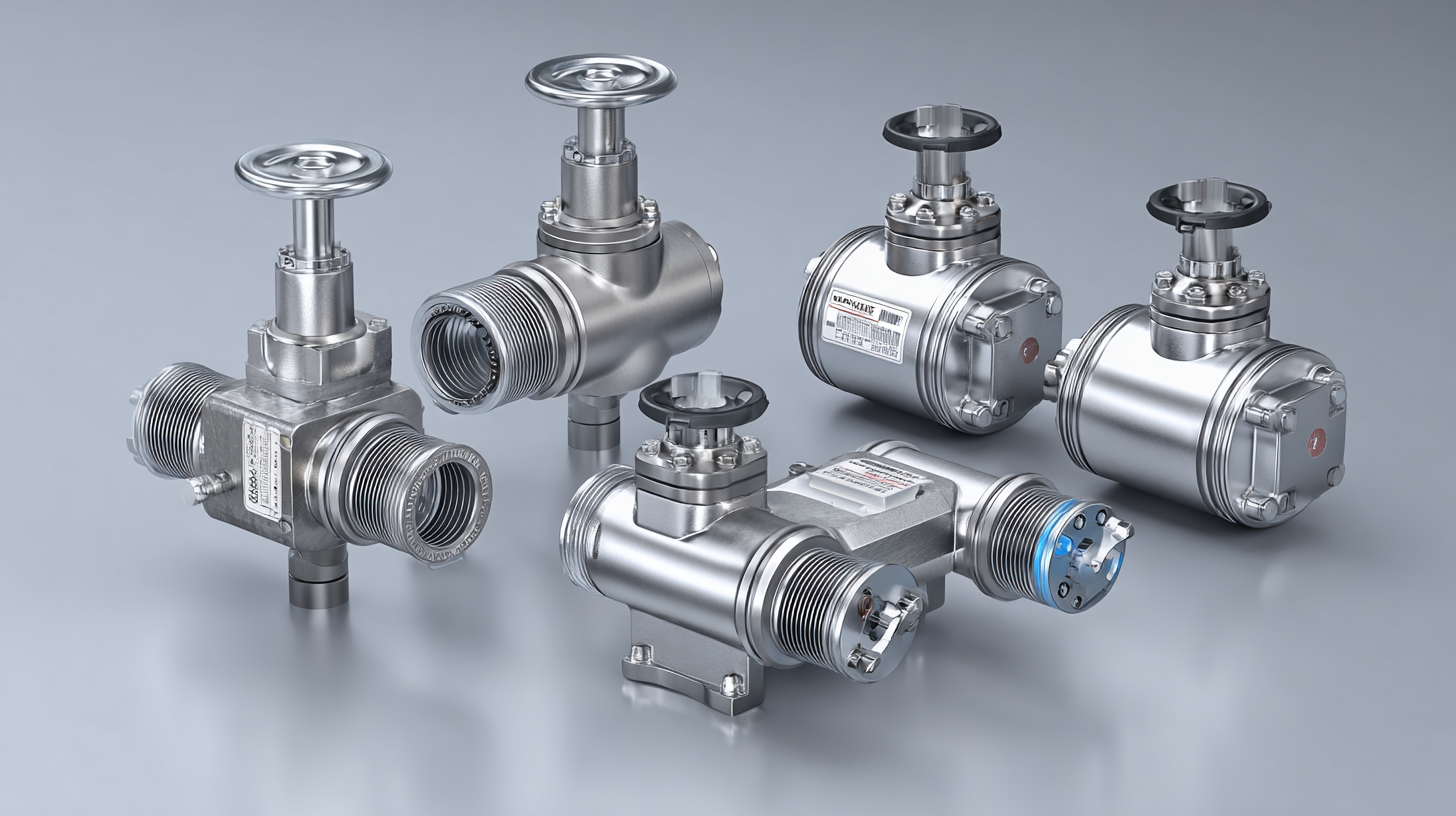Blog
- Home
- Blog
2025 Top Valve Applications for Innovative Industries and Effective Solutions
As industries continuously evolve to embrace innovation and efficiency, the role of valve applications becomes increasingly critical. In 2025, leading experts anticipate that these applications will be pivotal in transforming sectors such as pharmaceuticals, renewable energy, and smart manufacturing. Dr. Emily Chen, a recognized authority in fluid control technology, emphasizes the importance of valves in modern engineering, stating, "The future of industrial processes hinges on the precision and adaptability of valve applications."
In this context, exploring the top valve applications across various innovative industries reveals not only trends but also effective solutions that enhance operational performance. As businesses strive to optimize efficiency while maintaining safety and compliance, understanding these applications becomes vital. This article delves into the "Top 10" valve applications expected to shape the future landscape, paving the way for advancements that prioritize sustainability and effectiveness in operations.
From automated systems in automotive manufacturing to seamless fluid management in chemical processing, the versatility of valve applications is unmatched and essential for fostering innovation. As we examine these leading applications, we can gain insights into how they will redefine efficiency and productivity across sectors.

Emerging Valve Technologies Shaping Innovative Industries in 2025
As we approach 2025, the valve industry is undergoing a significant transformation driven by emerging technologies. According to a recent report from Research and Markets, the global valve market is projected to grow from $71.3 billion in 2020 to nearly $103 billion by 2025, fueled by innovations such as smart valves and advanced automation. Smart valve technologies, integrated with IoT capabilities, are enabling real-time monitoring and predictive maintenance, which significantly enhance operational efficiency and reduce downtime.
Furthermore, the adoption of materials such as advanced composites and alloys is leading to the development of valves that are not only more durable but also capable of operating under extreme conditions. A report by Grand View Research indicates that the demand for high-performance valves in oil and gas, water and wastewater, and chemical applications is expected to increase by over 5% annually through 2025. This growth highlights the importance of innovative valve solutions in meeting the challenges of modern industries, ensuring sustainability, and improving process control.
Key Industries Driving Demand for Advanced Valve Solutions
As industries continue to evolve, several key sectors are driving the demand for advanced valve solutions in 2025. The energy sector, particularly renewable energy sources such as wind and solar, is at the forefront. The transition from fossil fuels to greener alternatives necessitates more efficient and reliable flow control measures, pushing innovators to develop valves that can withstand varying pressures and temperatures while maintaining maximum efficiency.

The pharmaceutical and biotechnology industries also contribute significantly to the demand for innovative valve applications. These sectors require extremely precise control of fluids in processes like drug formulation and production. The need for valves that not only ensure sterile conditions but also guarantee the integrity of sensitive substances is paramount. Consequently, manufacturers are focusing on creating smart valves with integrated monitoring systems to enhance operational efficiency and compliance with stringent regulations.
Additionally, the water treatment and management industry is increasingly seeking advanced valve technologies, driven by the global push for sustainable water resources. As urbanization and population growth rise, so does the need for sophisticated water distribution systems. Innovative valve solutions that can optimize flow and reduce wastage are essential in addressing these challenges, thereby making a significant impact in the pursuit of efficient resource management.
Sustainable and Eco-Friendly Valve Applications for the Future
As industries progress toward sustainability, the role of eco-friendly valve applications becomes increasingly crucial. In 2025, innovative solutions in valve technology are set to transform operational efficiency while minimizing environmental impact. These applications not only utilize sustainable materials but also implement advanced designs that reduce waste and energy consumption. By integrating renewable resources and smart technology, industries can enhance their performance while adhering to environmental standards.

Tips: When selecting valves for sustainable applications, consider materials like recycled metals or bio-based composites that lower your carbon footprint. Additionally, opt for manufacturers focused on sustainable practices, ensuring that your choice contributes to a greener supply chain.
Furthermore, the future of valve applications lies in automation and smart technology. By utilizing sensors and IoT connectivity, organizations can monitor valve performance in real time, allowing for quick adjustments and energy savings. This technology not only optimizes processes but also supports predictive maintenance, significantly extending the lifespan of valves.
Tips: Embrace smart valve solutions that offer data analytics and remote monitoring to improve your operational efficiency. Regularly update your technology to stay ahead in the sustainability game and reduce downtime.
Challenges and Opportunities in the Valve Market Landscape by 2025
The valve market is poised for significant transformation by 2025, driven by evolving industrial needs and technological advancements. As industries increasingly focus on automation and efficiency, the demand for advanced valve solutions that ensure precision and reliability is on the rise. Challenges such as stringent regulatory requirements and the need for sustainable practices present both hurdles and opportunities for manufacturers. The ongoing shift towards greener technologies necessitates innovative valve designs that can support renewable energy applications, such as wind and solar power.
Moreover, the integration of smart technologies into valve systems offers a pathway to overcome existing market challenges. By leveraging IoT and data analytics, operators can achieve enhanced monitoring and predictive maintenance, thus reducing downtime and operational costs. However, the transition to smart systems requires overcoming barriers such as high initial investment and the need for workforce training. As the valve market evolves, those who can navigate these complexities while delivering cutting-edge solutions will emerge as leaders in the innovative industries of the future.
2025 Top Valve Applications for Innovative Industries and Effective Solutions
| Application Area | Key Challenges | Opportunities | Market Growth Rate (%) |
|---|---|---|---|
| Oil & Gas | Regulatory compliance and aging infrastructure | Advancements in automation and monitoring technologies | 3.5 |
| Water Treatment | Water scarcity and pollution | Sustainable practices and smart water management | 4.0 |
| Chemical Processing | Safety hazards and stringent regulations | New materials and enhanced process controls | 3.8 |
| HVAC Systems | Energy efficiency and indoor air quality | Integration of IoT and AI for smarter systems | 5.2 |
| Power Generation | Aging infrastructure and demand for renewables | Adoption of renewable energy sources and technologies | 4.5 |
Integrating Smart Technology in Valve Systems for Enhanced Efficiency
The integration of smart technology into valve systems is poised to revolutionize industrial efficiency, particularly in the context of the rapidly evolving industrial valves market. As automation and smart technologies advance, industries are increasingly leveraging these innovations to enhance the operational effectiveness of their fluid handling systems. This shift not only drives productivity but also promotes sustainability by optimizing resource use, reducing waste, and minimizing energy consumption across various applications.
Recent advancements have shown that smart valves can adapt to changing conditions in real-time, providing precise control over fluid dynamics. This capability is particularly beneficial in critical sectors like offshore drilling and agriculture, where safety and resource management are paramount. For instance, smart technology in oil platforms has significantly improved efficiency, while in agriculture, innovations like smart hydrogels are enhancing water management, crucial for resilient farming practices. By embracing these intelligent systems, industries are setting the stage for a more efficient and sustainable future.
Related Posts
-
Understanding Guide Valves: Their Role in Fluid Dynamics with 2023 Industry Insights
-

Understanding the Role of Guide Valves in Modern Hydraulic Systems
-

Understanding Single Valve Systems: The Key to Efficient Fluid Control in Modern Engineering
-

Exploring the Advantages of Single Valve Systems for Efficient Fluid Control
-

Understanding the Role of Gate Valves in Modern Plumbing Systems
-

Why Forged Steel Valves Are Essential for Industrial Applications
 (780) 669-9420
(780) 669-9420

